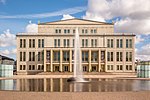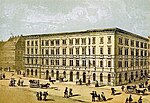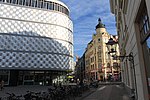Wintergartenhochhaus

The Wintergartenhochhaus is a 32-story high-rise building in Leipzig-Mitte, subdivision Ostvorstadt. The residential building was built from 1970 to 1972 as Wohnhochhaus Wintergartenstraße (residential high-rise on Wintergartenstrasse) and is the third tallest high-rise in Leipzig after the City-Hochhaus and the Hotel The Westin. With a total height of 106.8 m (350 ft) and 95.5 m (313 ft) roof height, it was the tallest residential building in the GDR and is now in the top hundred on the list of high-rise buildings in Germany. As a building of modernity and testimony of GDR architectural history with rarity value, it is under cultural heritage protection.
Excerpt from the Wikipedia article Wintergartenhochhaus (License: CC BY-SA 3.0, Authors, Images).Wintergartenhochhaus
Wintergartenstraße, Leipzig Centre East (Mitte)
Geographical coordinates (GPS) Address External links Nearby Places Show on map
Geographical coordinates (GPS)
| Latitude | Longitude |
|---|---|
| N 51.342706 ° | E 12.383868 ° |
Address
Wintergartenhochhaus
Wintergartenstraße 2
04103 Leipzig, Centre East (Mitte)
Saxony, Germany
Open on Google Maps











